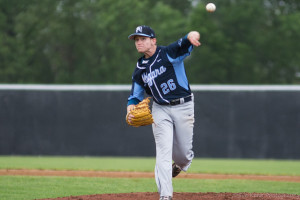
By ANTHONY SAMBROTTO
NIAGARA FALLS, N.Y. — For the 12-5 Niagara Power, wins have come in bunches this year. The team currently sits in first place in the Western Division of the New York Collegiate Baseball League. But behind the scenes, there is a system that helps grade the pitchers on much more than the wins and losses column.
The Power’s pitching staff is currently one of the best in the NYCBL and the main catalyst behind their 12 wins. The team ERA is 2.05 and opponents are only batting .223 against them. In addition, they have struck out 101 batters and only given up 33 earned runs. All of these numbers have the Power in the top three in each category in the NYCBL.
There is much more than the usual baseball statistics in Niagara, however.
Manager Josh Rebandt and assistant Jason Godbee have developed a quality start system as a way to more accurately grade pitchers on their performances.
Rebandt, who is in his third season with the Power, began using the system with the team last year. It was developed through a combination of systems he used as a player with the Power, as a coach at Olivet Nazarene University in Illinois, and the ideas of Bill James, a baseball statistician.
“This is something that is based on more than how many innings you throw or how many earned runs you give up, ” Rebandt said. ” There is a lot more that goes into pitching a quality start.”
Without further ado, the system works like this. Each starting pitcher begins the game with 50 points. That number goes up by one with each out recorded, up two with each inning completed after four, and up one after each strikeout. The deductions from the starting number of 50 come from minus two with each hit, minus four with each earned run, minus two for unearned and minus one for each walk and hit by pitch.
Staying above 50 is what marks a quality start for a pitcher. As a sign of just how good the starting pitching has been this summer, over the Power’s first 17 games, they have had 15 quality starts.
In addition to the quality start criteria, Rebandt also uses what he calls a “mini-game” to grade his pitchers. This gets much more into the nuances of pitching with points for no leadoff walks, first pitch strikes and for relievers not allowing runners to score after they have entered the game.
“I think this is a helpful tool for pitchers to understand what a quality start is, ” Rebandt said. ” If they go out there and don’t get any feedback, it’s hard to know how you’re really doing. You may have really good stuff one day and get hit around, or you don’t have the best stuff and you do well. ”
For example, the Power had two 4-1 losses earlier in the season that both qualified as quality starts for each of the starting pitchers in those games.
On the other end of the spectrum, a six-inning shutout from a starting pitcher still may not guarantee a quality start if that pitcher threw too many walks or allowed too many hits.
The two aces of the Power pitching staff have been Brandon Mumaw (St. Leo University) and Nathan Robinson (Cedarville University). Both pitchers are new to these kinds of advanced stats, but have adapted to them.
Mumaw, who boasts a 0.30 ERA, has been one of the top pitchers in the NYCBL this season, said ” I haven’t seen anything like it before. I have seen things that chart batters faced and number of strikes, but this system takes in a lot more to show how efficient you were.”

All four of Mumaw’s starts this year have been quality starts. According to Rebandt, Mumaw currently has the highest single game score of any Power pitcher this year with an 80. That was a complete game in which Mumaw had 10 strikeouts, had only one earned run, and didn’t walk a single batter.
On Rebandt’s office computer, he readily has available the record-holders in terms of quality starts in the big leagues. Former Chicago Cubs ace Kerry Wood has the record for a nine inning game with a score of 105 recorded in 1998 against the Houston Astros. That record was nearly broken this year by the Washington Nationals’ Max Scherzer, who reached 100.
Back in Niagara Falls, this system has helped Robinson work on specific aspects of his game. ” We get to see what we need to work on from start to start,” Robinson said. ” For me, it was my first-pitch strikes. They weren’t very high over my first couple of starts but each game they have been getting better and better.”
Robinson is 3-0 this year with a 1.50 ERA. All four of his starts have been quality.
” You only get to start once a week as a starter, and you want to go out there and get a W for your team,” Mumaw said. ” But if you go out there and get a quality start and maybe the team doesn’t score the runs on offense, you can still keep your head up and know that you gave your team a chance to win.”
Start after start, Rebandt and Godbee will provide the pitchers with more and more stats until they finish up their campaign with the NYCBL in late July. And, if other coaches catch wind of this new way to evaluate pitchers, especially after the way the Power have been pitching, it may end up on some college campuses next spring.
“I tell the pitchers that I will give them as much information as they want to try and help them out,” Rebandt said. ” We have a routine in between starts that they go through with all the stats and I tell them to take as much as they can from this summer and apply it to get better. ”

Leave a Reply